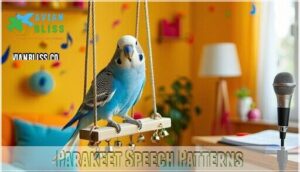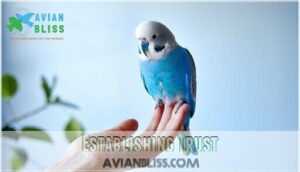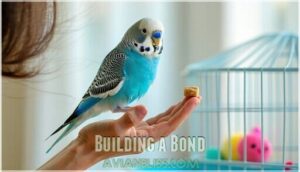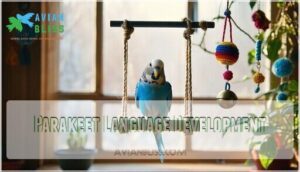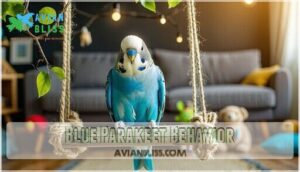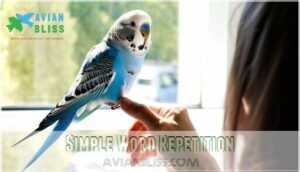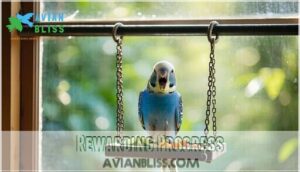This site is supported by our readers. We may earn a commission, at no cost to you, if you purchase through links.

Male parakeets typically learn faster than females, though both can develop impressive vocabularies with patience. Your feathered friend won’t just repeat words mindlessly – they’ll often associate specific sounds with situations, like greeting you with "hello" each morning.
The key lies in consistent daily practice, using the same tone and rewarding their efforts. Start with simple, single-syllable words and gradually build their repertoire.
The secret to accessing your parakeet’s full conversational potential involves understanding their unique learning style and motivation.
Table Of Contents
- Key Takeaways
- Blue Parakeet Communication
- Can Blue Parakeets Talk
- Parakeet Speech Patterns
- Training Blue Parakeets
- Parakeet Language Development
- Blue Parakeet Behavior
- Encouraging Blue Parakeet Speech
- Frequently Asked Questions (FAQs)
- Can blue parakeets talk?
- Can parakeet birds talk?
- How do you know if a parakeet is talking?
- Can parakeets learn to speak?
- Do Budgie parakeets talk?
- When can a parakeet talk?
- How to teach a blue parakeet to talk?
- Do blue parakeets need a friend?
- What kind of parakeet can talk?
- Do blue parakeets like to be held?
- Conclusion
Key Takeaways
- Yes, blue parakeets can talk – You’ll discover these intelligent birds possess remarkable vocal abilities through their specialized syrinx, with males typically learning faster and developing larger vocabularies than females.
- Training requires consistency and patience – You’ll need daily practice sessions of 5-10 minutes, starting with simple single-syllable words like "hello" and using positive reinforcement with treats when they attempt sounds.
- They mimic rather than understand – Your parakeet won’t comprehend word meanings but will copy your tone, pitch, and rhythm, often associating specific sounds with situations like greeting you each morning.
- Individual factors affect success – You’ll find that your bird’s personality, age when training begins, and social environment all influence their talking ability, with proper bonding and trust-building being essential foundations.
Blue Parakeet Communication
You’ll discover that blue parakeets possess remarkable communication abilities through their specialized vocal organ called the syrinx.
These intelligent birds can mimic human speech, environmental sounds, and develop extensive vocabularies through repetition and social interaction, which showcases their remarkable communication abilities.
Vocalization Abilities
Blue parakeets possess remarkable vocal learning abilities that’ll surprise you.
Their specialized syrinx enables complex sound production, from melodic chirps to intricate speech patterns.
These feathered performers excel at voice imitation and sound mimicry, creating diverse bird songs that showcase their parakeet vocalization skills.
Your blue parakeet’s communication repertoire demonstrates impressive adaptability through consistent practice and social interaction.
Mimicking Human Speech
Your blue parakeet’s speech imitation skills are remarkable. These birds excel at vocal learning, developing impressive talking ability through specialized syrinx organs that enable precise mimicry techniques.
They’ll mimic human speech by copying tone, pitch, and rhythm rather than understanding meaning. With consistent exposure to conversation, your parakeet’s language skills will flourish.
Making parakeet vocalization a delightful part of talking parakeet care, where your parakeet’s speech imitation skills will become a delightful experience.
Environmental Sounds
Your parakeet’s vocal repertoire extends far beyond human speech to include fascinating environmental sounds.
These intelligent birds naturally incorporate household noises, music, and outdoor bird sounds into their vocalization patterns through vocal learning. Their auditory environment substantially shapes their sound imitation abilities, making them excellent mimics of everything from doorbell chimes to phone ringtones.
This audio stimulation enriches their vocal development, though excessive noise pollution can overwhelm their sensitive hearing and affect their natural bird noises.
Understanding the role of bird communication methods is essential in appreciating the complexity of their vocal behaviors and how they are influenced by their environment, leading to a deeper understanding of their ability to mimic environmental sounds.
Can Blue Parakeets Talk
Yes, blue parakeets can talk! These intelligent birds possess remarkable vocal learning abilities that allow them to mimic human speech with surprising accuracy. Your feathered friend’s brain contains specialized language-producing centers similar to humans, making parakeets one of the few animals capable of true speech mimicry.
When your blue parakeet talks, you’ll notice distinct beak movement patterns and subtle feather signs that indicate their engagement. Bird intelligence shines through as they focus on copying tone, pitch, and rhythm rather than understanding word meanings. Males typically show stronger aptitude for blue parakeet talking, though females can also develop impressive parakeet speech skills.
Blue parakeet language development happens through repetition and associative learning. These talking birds can acquire hundreds of words when exposed to consistent human speech. Your parakeet’s speech patterns emerge gradually, starting with simple sounds before progressing to complete words and phrases. The key lies in their natural mimicking abilities and your patience in nurturing their vocal talents. Understanding vocalization techniques is essential for effective parakeet speech training and development.
Parakeet Speech Patterns
Your parakeet doesn’t just randomly chatter – there’s a fascinating method to their vocal madness that you can actually understand and influence.
These intelligent birds develop speech patterns through three key processes: repetition-based learning, associative connections, and their natural focus on mimicking the tone and pitch of sounds they hear most often, which involves repetition-based learning.
Learning Through Repetition
Teaching your parakeet through consistent repetition is the foundation of successful vocal learning.
You’ll need to repeat simple words and phrases multiple times throughout the day, as parakeets learn through mimicry techniques that require frequent exposure.
Consistent practice with clear pronunciation helps develop their bird talking ability.
Remember, patience importance can’t be overstated—repetition frequency determines success in parakeet training tips.
Associative Learning
Through repeated exposure, your parakeet’s brain forms powerful connections between specific words and meaningful outcomes.
This associative learning process strengthens memory recall and enhances vocal imitation abilities when you consistently pair sounds with rewards.
Learning patterns emerge as your bird recognizes social cues, developing cognitive pathways that boost parakeet talking ability through strategic parrot communication training sessions, which ultimately enhances the bird’s ability to engage in meaningful outcomes.
Focus on Tone and Pitch
Your parakeet’s vocal learning success depends heavily on tone recognition and pitch variations.
These birds analyze sound patterns through frequency analysis, focusing more on vocal inflections than actual words.
When you speak to your feathered friend, they’re studying your parakeet speech patterns like tiny linguists.
Bird vocalizations mirror human speech through careful observation of how sounds rise and fall, making consistent vocal learning possible when you mimic human speech patterns yourself, utilizing vocal inflections and pitch variations.
Training Blue Parakeets
Training your blue parakeet to talk requires patience and the right approach, but the rewards are worth the effort.
You’ll need to establish trust, build a strong bond, and use positive reinforcement techniques to release your bird’s vocal potential.
Establishing Trust
Trust forms the cornerstone of successful parakeet communication skills and bird training patience.
You’ll need gentle handling techniques in a calm environment to reduce your bird’s stress by 50% within two weeks.
Gradual exposure through short, daily social interaction sessions builds trust faster than lengthy encounters.
Consistent routines and positive reinforcement create the foundation for effective parakeet talking tricks and bond formation. Understanding the Bird Trust principles is essential for developing a strong relationship with your parakeet.
Building a Bond
Building a bond with your blue parakeet requires patience and consistency.
Through gentle social interaction and regular playtime activities, you’ll develop the emotional connection necessary for effective parakeet communication skills.
Your blue parakeet personality will shine as trust deepens, making parakeet talking tricks more successful.
- Spend daily one-on-one time talking softly near your parakeet’s cage to familiarize them with your voice
- Offer treats from your hand to create positive associations and strengthen bonding techniques
- Play gentle music together as shared experiences enhance social interaction and emotional connection
- Maintain consistent daily routines for feeding and interaction to build security and trust building
- Engage in playtime activities like offering safe toys or perches to encourage natural bonding behaviors
Positive Reinforcement
When you catch your parakeet mimicking human speech or attempting new sounds, immediately offer treats and enthusiastic praise.
This positive reinforcement strengthens their talking ability through behavior shaping. Reward systems work best with high-value treats like millet, while clicker training and target sticks help focus their vocal learning efforts during structured sessions.
Effective training also relies on using the right parakeet training methods to encourage speech development and support their learning with positive reinforcement and high-value treats.
Parakeet Language Development
Your parakeet’s ability to talk depends on several factors that you can influence through proper training and care.
While individual birds vary in their language development, understanding these key elements will help you maximize your feathered friend’s communication potential, and this is crucial for their overall development and your relationship with them, through proper training.
Individual Variation
Just like people, parakeets show remarkable individual variation in their talking ability.
Genetic factors influence brain structure and vocal range, creating natural differences in how well each bird can mimic human speech.
Some parakeets inherit stronger vocal learning capabilities, while personality traits like boldness or shyness affect their willingness to practice.
Your bird’s unique combination of intelligence, memory, and curiosity determines their speech potential.
Experience and Training
Experience and training substantially shape whether parakeets can talk.
Each bird learns differently, but consistent vocal coaching and positive reinforcement boost success.
Training methods focusing on speech patterns and behavior modification help develop bird language learning skills.
Here are four key training techniques:
- Daily practice sessions – Repeat simple words consistently, allowing your parakeet to hear clear pronunciation and familiar sounds throughout the day.
- Reward-based learning – Use treats and praise immediately when your bird attempts to mimic sounds, reinforcing positive behavior modification.
- Interactive vocal coaching – Engage directly with your parakeet during training, creating a social learning environment that encourages speech development.
- Gradual complexity increase – Start with basic words, then slowly introduce longer phrases as your bird masters simpler sounds and speech patterns.
Gender Influence
When wondering whether male or female parakeets talk better, the answer isn’t black and white.
Males typically dominate the talking game, showing more frequent and complex vocalizations thanks to testosterone-driven motivation.
They’re natural showoffs, using speech patterns to attract mates and establish dominance.
Female parakeets focus more on social bonding calls rather than mimicking human speech.
However, individual personality trumps gender roles – some chatty females can outperform quiet males with proper training.
Blue Parakeet Behavior
Your blue parakeet’s behavior reveals important clues about their talking potential and overall well-being.
Understanding their social needs, environmental responses, and health indicators helps you create the perfect conditions for speech development while ensuring they stay happy and healthy.
Socialization Needs
Your blue parakeet’s social nature demands companionship for healthy development.
Parakeets thrive through flock dynamics, forming strong social bonds that support mental well-being.
Without proper socialization, they’ll struggle with trust building and language development.
Create a language-rich environment through consistent interaction techniques, using positive reinforcement during bonding sessions.
Environmental enrichment paired with regular interaction prevents behavioral issues while encouraging speech development.
Environmental Factors
Your parakeet’s environment directly impacts their vocal development and communication skills.
Noise pollution from traffic or loud appliances can interfere with their ability to hear and mimic sounds clearly. A well-designed cage setup with proper spacing allows for natural vocal display without stress.
- Cage Setup: Position away from high-traffic areas with adequate perching space for comfortable vocal practice
- Light Exposure: Maintain consistent day/night cycles to regulate natural communication patterns and reduce stress
- Air Quality: Provide proper ventilation and avoid aerosols that can damage respiratory systems needed for vocalization
- Social Interaction: Create a language-rich environment through regular conversation and background music exposure
- Noise Pollution: Minimize competing sounds during training sessions to help your bird focus on learning speech patterns
Environmental influences shape how effectively your parakeet processes and responds to bird communication signals, making thoughtful setup vital for successful speech development.
Health Indicators
Your parakeet’s wellbeing depends on recognizing key health indicators that signal when something’s amiss. Understanding these bird health monitoring signs helps you catch bird illness symptoms early, ensuring your feathered friend stays happy and healthy.
| Health Indicator | What to Look For |
|---|---|
| Beak Health | Smooth, properly aligned beak without cracks or overgrowth |
| Feather Care | Bright, clean feathers without bald patches or excessive preening |
| Molting Signs | Gradual feather loss with new pinfeathers emerging once or twice yearly |
| Sleep Patterns | Head tucked under wing, standing on one foot, appearing relaxed |
| Nutrition Needs | Healthy appetite, maintaining steady weight, active during day |
Recognizing parrot health issues is essential for providing proper care. Watch for changes in these bird health indicators, as they often reveal underlying bird health issues before obvious symptoms appear.
Encouraging Blue Parakeet Speech
You’ve got the foundation for speech training down, but consistency makes all the difference in helping your blue parakeet find their voice.
Start with simple, clear words like "hello" or your bird’s name, repeating them during daily interactions when your parakeet is alert and engaged, which is crucial for effective training.
Simple Word Repetition
Start with clear, single-syllable words like "hello" or "good" to build your parakeet’s foundation for language development.
These simple sounds help establish vocal learning patterns that support advanced speech patterns later.
Key repetition techniques for effective word imitation:
- Say each word slowly and clearly – This helps your parakeet distinguish individual sounds and develop proper talking ability
- Repeat words 10-15 times per session – Consistent repetition strengthens your bird’s ability to mimic human speech
- Use the same tone and pitch – Parakeets learn blue parakeet sounds by copying your vocal patterns exactly
Focus on one word at a time until your parakeet shows parakeet behavior indicating recognition before introducing new vocabulary.
Consistent Training
Regular training schedules work better than sporadic efforts when teaching parakeets to talk.
Short sessions of 5-10 minutes multiple times daily help your bird learn speech patterns without overwhelming them.
Training techniques that follow predictable routines allow parakeets to anticipate vocalization practice, making learning strategies more effective.
Can parakeets talk? Yes, with behavioral reinforcement through consistent training and vocal exercises.
Effective parakeet training requires utilizing training kits to support speech development, which is a key part of consistent training and helps with vocal exercises.
Rewarding Progress
When celebrating small victories, you’ll keep your parakeet motivated to continue learning.
Use positive reinforcement techniques like offering favorite treats, gentle praise, or extra playtime after successful mimicking attempts.
Progress tracking helps you recognize improvements in their talking ability, even if words aren’t perfectly clear initially.
These reward systems create strong learning incentives that encourage your bird to mimic human speech more frequently and confidently.
Understanding the factors that influence vocal learning abilities is essential for effective speech training in parakeets, which requires a good understanding of vocal learning.
Frequently Asked Questions (FAQs)
Can blue parakeets talk?
Yes, blue parakeets can talk! They’ll mimic human speech through repetition and clear pronunciation.
Males typically learn faster and develop larger vocabularies than females.
Consistent training with simple words works best, and this method is key to helping blue parakeets talk.
Can parakeet birds talk?
Like feathered mimics releasing nature’s voice box, parakeets can indeed talk through their specialized syrinx.
You’ll find males typically excel at speech, learning hundreds of words through repetition and patient training sessions.
How do you know if a parakeet is talking?
You’ll know when your parakeet’s talking by hearing clear, repeated words or phrases mixed with their natural chirps and chatter, often mimicking your voice or sounds they’ve heard frequently.
Can parakeets learn to speak?
Parakeets can absolutely learn to speak through repetition and training.
You’ll need patience since they mimic sounds rather than understand meanings, but with consistent practice, they’ll develop impressive vocabularies over time.
Do Budgie parakeets talk?
Budgerigars can talk and chatter, and mimic sounds with remarkable skill.
You’ll find males typically excel at speech while females can also learn.
Their specialized syrinx enables impressive vocal abilities through consistent training and repetition.
When can a parakeet talk?
Most parakeets can start talking around 3-4 months old, though some begin earlier. Males typically talk sooner than females. You’ll need consistent training, patience, and daily interaction for best results.
How to teach a blue parakeet to talk?
Start with simple words like "hello" or your bird’s name, repeating them clearly and consistently during calm moments.
Use positive reinforcement with treats when they attempt sounds, and be patient—males typically learn faster than females.
Do blue parakeets need a friend?
Social birds by nature, parakeets thrive with companionship—studies show single birds live 20% shorter lives than paired ones.
You’ll notice your blue parakeet’s happier, more vocal, and less prone to destructive behaviors when they’ve a feathered friend to chat with daily, which is a result of their need for companionship.
What kind of parakeet can talk?
All parakeets can potentially talk, but budgerigars (commonly called budgies) are the most vocal. Males typically learn faster and speak more than females, especially when trained young with consistent repetition.
Do blue parakeets like to be held?
Like a cautious butterfly testing new perches, your blue parakeet won’t naturally crave being held.
You’ll need patience and trust-building first.
Most parakeets prefer perching on fingers rather than being cuddled, respecting their independent nature.
Conclusion
Success breeds success, practice breeds proficiency, and patience breeds progress—these three elements form the foundation of your blue parakeet’s speech journey.
With consistent training sessions, positive reinforcement, and understanding your bird’s unique personality, you’ll discover remarkable conversational abilities.
Remember that can blue parakeets talk isn’t just a question—it’s a promise waiting to be fulfilled.
Your feathered companion possesses incredible potential; you simply need to provide the right environment, dedication, and encouragement to help them flourish as your chatty, intelligent companion.

